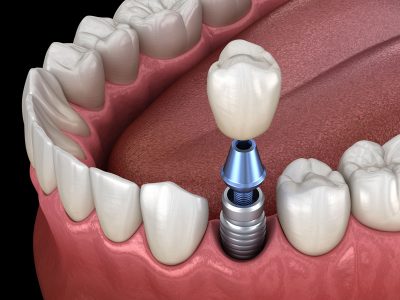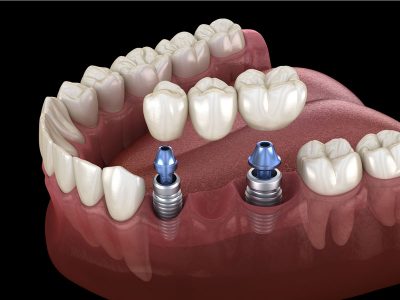DENTAL IMPLANTS
A dental implant is a replacement for a missing tooth.
It is categorised as prosthetic dentistry and it is also viewed as a form of cosmetic dentistry.
Dental implants are an important treatment for preventing bone loss, which is a common side effect of a missing tooth.
The implant is situated within the bone of the jaw where it stimulates new bone growth and retains the structure of your jaw.
REPLACEMENT OPTIONS

One Tooth
When you have one tooth missing, a single implant is inserted into the bone to replace the root part of that tooth; a crown then goes on top to simulate an actual tooth.

Multiple Teeth
When you have more than one tooth missing, implants provide an ideal replacement mechanism. You don’t even need one implant for every missing tooth. Instead, implant teeth can act as supports for fixed bridgework.

Full Arch
Implants can support an entire arch of upper or lower replacement teeth that are fixed into the mouth and are never removed.
Implants can even make removable dentures more comfortable, effective and healthier to wear.
HOW A DENTAL IMPLANT IS PLACED
The process starts with the dentist checking the state of your teeth and gums and taking an x-ray if necessary. If there is a dental problem such as tooth decay then this will be treated before the placing of the implant.

Step 1
The first step involves the surgical aspect of the procedure where the implant itself is placed into your jaw bone. The implants can be placed in either your top jaw, bottom jaw, or both. It usually takes at least 6 months for the implant to properly integrate into your bone.
Step 2
The second step of the process involves placing the abutment on top of the titanium post. The post must be fully healed in the gum before the abutment is set. Once you are ready for the abutment, it is attached to the post via a screw. This is the piece that is responsible for connecting the crown and implant to each other.
Step 3
Now it is the third step and this step is the implant restoration process. During this time, a crown is made to go over the abutment. The crown is either made from all porcelain, metal, or porcelain fused to metal. The crown will then be cemented to the abutment and will remain in place permanently.

